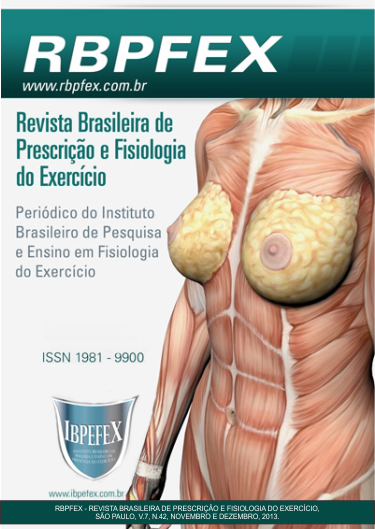Stretching the influence of maximum strength through test 1RM
Abstract
Introduction: The present article is of observations concerning the influence of muscle stretching, with regard to the performance of maximum strength, notwithstanding the benefits related to muscular performance and the prevention of lesions of the individual. Objective: The study aims to rethinkthe stretch in the case of amount of force driven by the individual and their performance, taking into account various factors that may clarify the controversies present in different surveys. Materials and Methods: We conducted a test of one repetition maximum (1RM) in 21 male volunteers with a mean age of 23.04 years (± 3.5), body mass of 76.35 kg (± 13.9) and height of 175 cm (± 6.0) engaged in resistance exercise. As a tool to indicate the measurement of the maximum force with and without stretching in order to better observe the satisfactory performance training. Results: The study results showed that the majority of identified individuals could achieve a higher performance of maximal voluntary strength when strength testing was preceded heating only with the presence of a statistically significant difference (p <0.05). Discussion: Similar results were found from the application of knowledge of other scholars confirmed that the use of stretching before activities that require maximum force can be harmed when we analyze the performance factor (Shrier, 2004). Conclusion: There was a contraindication of stretching exercises before the test repetition maximum because there is reduction in their performances.
References
-Alter, M. Ciência da flexibilidade. Porto Alegre. Artmed. 2a edição. 1999.
-Arruda, F.B.; Faria. L.B.; Silva. W.; Simão, R.; Senna. G.W.; Novaes, J.; e colaboradores. A influência do alongamento no rendimento do treinamento de força. Rev. Treinamento Desportivo. Vol. 7. p. 1-5. 2006.
-Baechle, T.R.; Earle R.W. Essential of Strength Training and Conditioning. Champaign. Human Kinetics. 2000.
-Endlich, P. W.; Farina, G. R.; Dambroz, C. S.; Gonçalves, W. L. S.; Moysés, M. R.; Mill, J. G.; Abreu, G. R. de. Efeitos Agudos do Alongamento Estático no Desempenho da Força Dinâmica em Homens Jovens. Vitória,ES. Rev Bras Med Esporte. Vol. 15. Num. 3. Mai/Jun. 2009.
-Fleck, S.J.; Kraemer, W.J. Designing Resistance Training Programs. Champaing. Human Kinetcs. 1997.
-Fowles, J. R.; Sale, D. G.; Macdougall, J. D. Reduced strength after passive stretch of the human plantarflexors. J Appl Physiol. Vol. 89. Núm. 3. p. 1179-1188. 2000.
-Manffra, E. F.; Grego, A. N. Influência do volume de alongamento estático dos músculos isquiotibiais nas variáveis isocinéticas. Curitiba. Rev Bras Med Sport. Vol. 15. Núm. 2. 2009.
-Marek, S. M.; Cramer, J. T.; Fincher A. L.; Massey, L. L.; Dangelmaier, S. M.; Purkayastha, S. Acute Effects of Static and Proprioceptive Neuromuscular Facilitation Stretching on Muscle Strength and Power Output. J Athl Train. Vol. 40. Núm. 2. p. 94-103. 2005.
-Rubini, E. C.; Costa, A. L. L.; Gomes, P. S. C. The effects of stretching on strength performance. Sports Med. Vol. 37. Núm. 3. p. 213-224. 2007.
-Shrier, I. Does stretching improve performance? A systematic and critical review of the literature. Clin J Sport Med. Vol. 14. p. 267-273. 2004.
-Simão, R.; Poly, M.A.; Lemos, A. Prescrição de exercícios através do teste de T1 RM em homens treinados. Fitness & Performance Journal. Vol. 3. Num. 1. p. 47-51. 2004.
-Winchester, J. B.; Arnold, G.; Nelson, J. K. A Single 30-s Stretch Is Sufficient to Inhibit Maximal Voluntary Strength. Research Quarterly for Exercise and Sport. Vol. 80. Num. 2. p. 257-261. 2009.
-Young, W.; Elliot, S. Acute Effects of Static Stretching, Proprioceptive Neuromuscular Facilitation Stretching and Maximum Voluntary Contractions on Explosive Force Production and Jumping Performance. Research Quarterly for Exercise and Sport. Vol. 72. Num.3. p. 273-279. 2001.
Authors who publish in this journal agree to the following terms:
- Authors retain the copyright and grant the journal the right of first publication, with work simultaneously licensed under the Creative Commons Attribution License BY-NC which allows the sharing of the work with acknowledgment of the authorship of the work and initial publication in this journal.
- Authors are authorized to enter into additional contracts separately for non-exclusive distribution of the version of the work published in this journal (eg, publishing in institutional repository or book chapter), with acknowledgment of authorship and initial publication in this journal.
- Authors are allowed and encouraged to post and distribute their work online (eg, in institutional repositories or on their personal page) at any point before or during the editorial process, as this can bring about productive change as well as increase impact and impact. citation of published work (See The Effect of Free Access).






